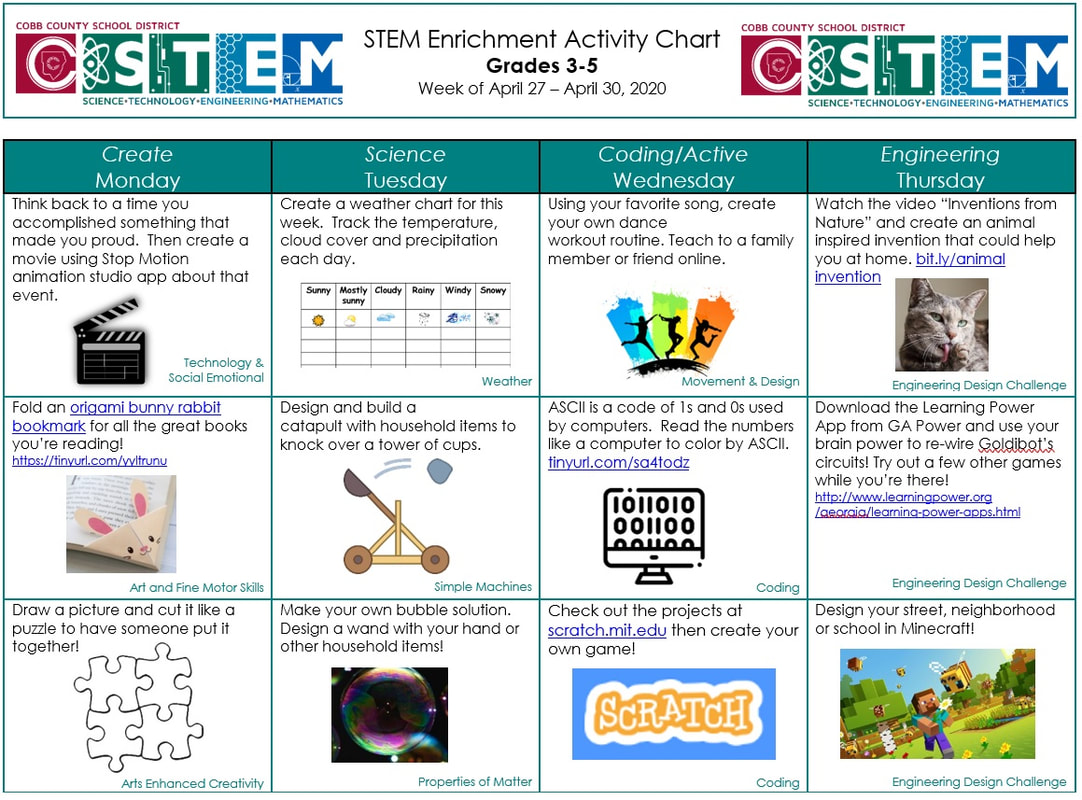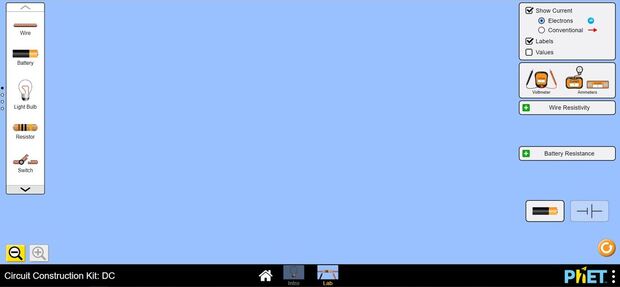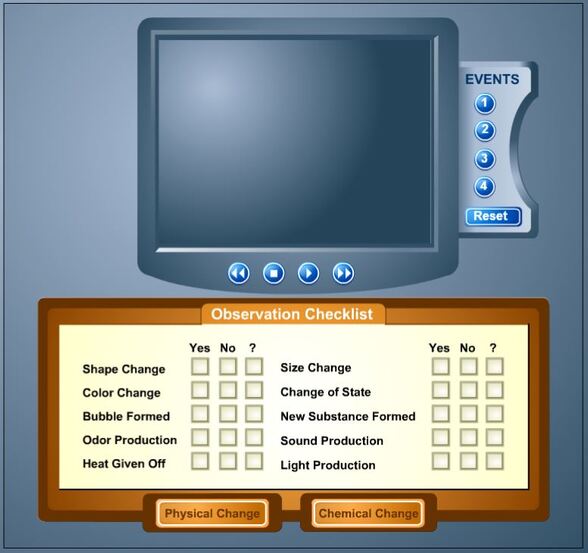| 3-5 Choice Board 3.docx |
|
0 Comments
It's STEM Challenge time! This week we are taking on the study of circuits and electricity! Students in older grades are asked to design a complete simple circuit and explain the necessary components (S5P2.b). For this week's challenge, students will also be asked to exercise their math skills by identifying acute, right, and obtuse angles that exist in their circuits (MGSE4.G.1).
Materials: paper pencil computer This week, we are going to start with an amazing song that explains the basics of current (or moving) electricity. Watch it once to enjoy the animation and beat, watch it again to be sure you understand what the words are teaching you! Type in your name and click "Join Session" below. This session will stay active until May 23rd.
Let's jump into it! This week's challenge is going to look a little different. You are going to open a digital circuit builder and then scroll down for your specific challenges- you will have to click back and forth between this screen and your circuit builder screen. This circuit builder has a built-in tutorial if you're not sure how to use it! Click on the image below to open it up, then come back for your challenges below!
Now that you've found the circuit builder, here are your challenges for this week!
CHALLENGE 1: Light the light bulb You may use: ONE light bulb, ONE battery, and ONE wire. I promise it's possible! Math connection: Can you identify ONE acute angle in your circuit? CHALLENGE 2: Light the light bulb You may use: ONE light bulb, ONE battery, and TWO wires Math connection: Give your circuit ONE right angle. CHALLENGE 3: Light the bulb with a switch You may use: ONE light bulb, ONE battery, THREE wires, and ONE switch. Math connection: How many angles can you find and record? STEM ENGINEERING CHALLENGE: Ask yourself, can I construct a testing station to see if common items will allow electricity to pass through them? We call materials that allow electricity to flow CONDUCTORS. We call materials that stop electricity INSULATORS. Use the down arrows on your tool bar to get to some materials for testing. You should see things like a dollar bill, eraser, a coin, and more! Brainstorm a way to see if these items will allow electricity to pass through them. Create a circuit with a gap for testing! Try out some different things to see if they are conductors or insulators. Record your results! Evaluate your design- could you tell which items were conductors and which were insulators? Improve your design if you need to! Did you get stuck? Scroll down for some pictures of possible correct solutions for the challenges! Keep scrolling for answers! Here are a few possible answers! Yours might look a little different depending on where you put the parts, but as long as you used the correct number of pieces and lit the bulb, you did it!
Welcome back to another great week of STEM learning! Hopefully you have MANY answers to the question, "Why do we wear clothes?" but this week we are tying our need to clothe ourselves with the 3rd grade science and study of HEAT! In 3rd grade, students learn to use tools and every day materials to design and construct a device/structure that will increase/decrease the warming effects of sunlight on various materials (S3P1.c). They also study the mathematical concept of AREA , which will be important for our challenge today (MGSE3.MD.6). Materials: paper bag clothespins paper towels plastic spoon string pencil paper **These materials are listed for our activity, but please use whatever you have! This is a great activity for getting creative and using what's available! Just as great scientists start their studies with reading, so do we! Here's a great book about the sun's energy! This week, we have a second very exciting video to share with you. This video is interactive, so discuss what you think with your parents when the video stop and asks you questions! Enjoy taking a little time to learn about heat and the different reasons that we use different types of materials. This video will also be introducing our challenge for today! Listen closely at the end, and if you miss it, just read below for a recap. Click on the picture to go to the Mystery Science video. This link will work until June 30th. Here's a recap of your STEM challenge for this week! You are going to be using simple materials to make a HAT to keep you cool. You learned in the video that hats made for keeping us cool have a stiff brim to shade us from the sun. Once you've made your hat, you're going to try and find the area of your brim to make sure you've made the best use of your materials. Ask yourself, how can I arrange my materials to make the best hat for shading myself? Take some time to brainstorm ideas. Use your materials to create your hat. Step outside on a sunny day and see if it provides the shade you'd hoped. Evaluate: Does my hat shade my head and neck in the best way possible? Take some time to improve your design!
If you can, snap a picture of you in your hat and share it on social media! We would love to see your amazing creations on Twitter (@stemcobb) and Facebook (www.facebook.com/Stemcobb). Welcome back from Spring Break! This week, we are going to tackle chemical changes. Students in upper grades are asked to plan and carry out investigations to determine if a chemical change has occurred based on observable evidence (S5P1.c). Students are also asked to generate and analyze patterns- which is PERFECT for writing and deciphering secret messages (MGSE4.OA.5). Materials you will need: paper, markers, lemon juice, baking soda, grape juice, milk, Q-tips, and a flame-less heat source like a hair dryer or a lamp without a lampshade. Optional items: ingredients for baking cookies, bread, or any other baked good We would normally begin with a video of a read aloud that's connected to our subject, but this one can be a little tricky! Here's a great short video clip that summarizes all you need to know about physical and chemical changes. Here's an interactive game that will test your knowledge of physical and chemical changes. Give it a try! It will check your answers as you go along. Click the photo to visit the site. (Note: game requires Adobe Flash Player) Here's an optional bonus activity - spend some time with a family member as you bake something together. When you bake, you are chemically changing the ingredients to become a tasty treat! Once you feel confident that you can determine the difference and physical and chemical changes, it's time to take on your STEM challenge! Ask yourself, how can I use household items to try and create secret messages that can only be revealed with heat? Give your messages one additional level of security by creating an alphabetic code that uses patterns to write your messages. Brainstorm some ideas and do some materials testing. Which type of chemical works the best? Create your secret code and give it to a family member to decipher. Evaluate: Could I try another material or combination of liquids to get better results? Can you improve your messages? If you're stuck on how to create your code, check out this video and try out the Pigpen Cipher! |
AuthorThese activities are being compiled by your STEMCobb team. Archives
May 2020
Categories |
||||||





 RSS Feed
RSS Feed